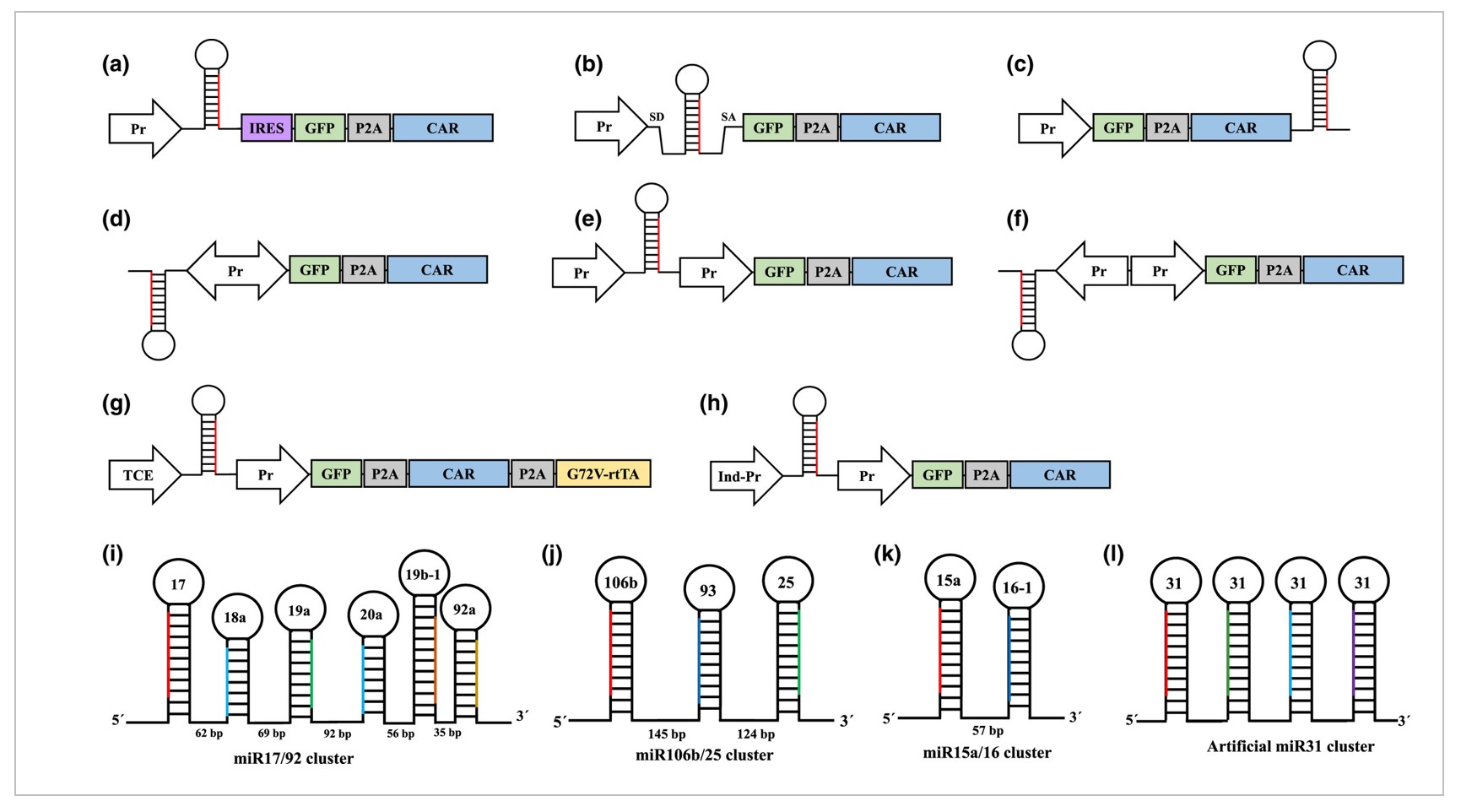All products and services are For Research Use Only and CANNOT be used in the treatment or diagnosis of disease.
miRNAs play an important role in T-cell proliferation and differentiation. For example, some research utilizes miRNAs silencing inhibitory receptor transcripts to overcome T cell-intrinsic dysregulations and promote tumor regression. Therefore, the introduction of miRNA cassette in a CAR vector can overcome barriers limiting CAR T cell effectiveness and enhance the effector function of CAR-T cells. At Creative Biolabs, we are committed to developing ground-breaking cell therapies. Based on the CAR-T platform, we have developed a miRCAR-T platform involving the overexpression of miRNA within CAR-T cells. The miRCAR platform may offer a simpler, more effective, and more efficient method for cancer therapies.
A miRCAR construct involves the coexpression of miRNA genes with a CAR gene in T cells. The construction of a miRCAR can be achieved through a variety of strategies shown in Fig.1. A miRCAR construct can use a single DNA cassette or two separate viral vectors to encode the selected miRNA and CAR. The all-in-one vector is usually better than separate vectors.
The elements required in a miRCAR
 Fig.1 Strategies of all-in-one miRCAR vector design.1
Fig.1 Strategies of all-in-one miRCAR vector design.1
The miRNAs can regulate T cell functions by several mechanisms. The overexpression of specific miRNAs in CAR T cells can:
The following are some important miRNAs that can potentially modulate the function of T cells. These miRNA candidates combined with a CAR have the potential to improve the antitumor immune responses.
| miRNAs: | miR-214 | miR-146a | miR-23a | miR-150 | miR-155 |
| Target: | PTEN | NF-κB | Blimp-1 | IL-2Rα, ARRB2 | SHIP-1, SOCS-1 |
| miRNAs: | miR-143 | miR-17-92 | miR-15/16 | miR-342 | miR-139 |
| Target: | Glut-1 | PHLPP2, PTEN | BCL2 | EOMES, perforin | EOMES, perforin |
| miRNAs: | miR-28 | miR-138 | Let-7 | miR-181a | |
| Target: | CTLA-4, PD-1 | CTLA-4, PD-1 | CCR2, CCR5 | DUSP5, DUSP6, PTPN11, PTPN22 |
For more miRNA information please contact us.
Support Data
The following are miRNAs introduced into CAR T-cells in some studies.
| miRNAs | Target | CAR T cells | Function |
| miR-155 | SOCS-1 | anti-CD19 CAR T-cells | Enhances trafficking and promotes an effective antitumor response |
| miR-143 | Glut-1 | anti-HER2-CAR T cells | Promote memory T cell development |
| miR-17-92 | PHLPP2, PTEN | anti-EGFRvIII CAR T-cells | Enhance cell proliferation, persistence, and differentiation |
Reference
For any technical issues or product/service related questions, please leave your information below. Our team will contact you soon.
 NEWSLETTER
NEWSLETTER
The latest newsletter to introduce the latest breaking information, our site updates, field and other scientific news, important events, and insights from industry leaders
LEARN MORE NEWSLETTER NEW SOLUTION
NEW SOLUTION
CellRapeutics™ In Vivo Cell Engineering: One-stop in vivo T/B/NK cell and macrophage engineering services covering vectors construction to function verification.
LEARN MORE SOLUTION NOVEL TECHNOLOGY
NOVEL TECHNOLOGY
Silence™ CAR-T Cell: A novel platform to enhance CAR-T cell immunotherapy by combining RNAi technology to suppress genes that may impede CAR functionality.
LEARN MORE NOVEL TECHNOLOGY NEW SOLUTION
NEW SOLUTION
Canine CAR-T Therapy Development: From early target discovery, CAR design and construction, cell culture, and transfection, to in vitro and in vivo function validation.
LEARN MORE SOLUTION